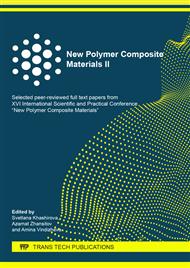[1]
O.A. Krotova, A.V. Kasperovich, Zh.S. Shashok, E.E. Potapov, S.V. Reznichenko, Features of adhesive properties of rubber-metal cord systems with modified silicic acid fillers, Kauchuk i rezina. 4 (2016) 28-33.
Google Scholar
[2]
O.A. Krotova, A.V. Kasperovich, Zh.S. Shashok, Synthesized cobalt and nickel-containing adhesion promoters as part of model elastomeric compositions, Trydy BGTU I. 4. Khimiya, tekhnologiya organicheskikh veshestv i biotekhnologiya . 186 (2016) 67-72.
Google Scholar
[3]
Z.B. Portnoyi, Features of the modifying action of cobolt-containing promoters in rubber compounds for a metal cord tire breaker, Kauchuk i rezina. 2 (2004) 25-28.
Google Scholar
[4]
D.I. Fazylova, l.A. Zenitova, Polymeric Composite Material for Medical Purposes, Key Engineering Materials. 816 (2019) 250-254.
DOI: 10.4028/www.scientific.net/kem.816.250
Google Scholar
[5]
P.J. Hine, S.E. Muddarris, D.E. Packham, Adhesion of microfibrous surfaces on steel and copper to epoxy resins, J. Adhes. Sci. Technol. 1 (1987) 69-78.
DOI: 10.1163/156856187x00085
Google Scholar
[6]
I.L. Shmurak, Ways to increase the stability of the adhesive bond metal cord-rubber, Kauchuk i rezina. 12 (1982) 13-18.
Google Scholar
[7]
R.L. Vesnin, Elastomeric compositions with a new multifunctional ingredient based on 2-polysulfobenzoic acid imide, Diss. ... kand. tehnich. nauk, Kirov, (2009).
Google Scholar
[8]
A.R. Kurbangaleeva, A.I. Kurkin, Y.N. Khakimullin, Structure and properties of Thiokol sealants modified with organosilanes, Russian Journal of Applied Chemistry. 85 (2012) 432-436.
DOI: 10.1134/s1070427212030196
Google Scholar
[9]
X. Shi, M. Ma, C. Lian, D. Zhu, Investigation of the effects of adhesion promoters on the adhesion properties of rubber/steel cord by a new testing technique, Journal of Applied Polymer Science. 131 (2014) 39460.
DOI: 10.1002/app.39460
Google Scholar
[10]
W.J. Ooij, Fundamental aspects of rubber adhesion to brass-plated steel tire cords, Rubber Chem. Technol. 52 (1979) 605-675.
DOI: 10.5254/1.3535231
Google Scholar
[11]
W.J. Van Ooij, Mechanism and theories of rubber adhesion to steel tire cords - an overview. Rubber Chemistry and Technology. 57 (1984) 421-456.
DOI: 10.5254/1.3536016
Google Scholar
[12]
W.J. Van Ooij, V. Rangarajan, Interfaces Between Natural Rubber and Metals. Part I. A Study of the Interaction Between Squalene and Steel Using XPS and SIMS, Rubber. Chemistry and Technology. 61 594-608.
DOI: 10.5254/1.3536206
Google Scholar
[13]
S.K. Jayaseelan, W.J. Van Ooij, Rubber-to-metall bonding by silanes, Gummi, Fasern, Kunststoffe, 56 (2003) 497-509.
Google Scholar
[14]
N.F. Lukina, L.A. Dement'eva, A.P. Petrova, T.Y. Tyumeneva, Рroperties of adhesives and adhesive materials used in aviation industry, Polymer Science, Series D. 2 (2009) 147-154.
DOI: 10.1134/s1995421209030034
Google Scholar
[15]
D.A. Kardashov, A.P. Petrova, Polymer adhesives, Khimiya, Moscow, (1983).
Google Scholar
[16]
T.Y. Tyumeneva, N.F. Lukina, VKR-95 cold-setting adhesive with enhanced strength, Polymer Science, Series D. 3 (2010) 114-116.
DOI: 10.1134/s1995421210020085
Google Scholar
[17]
R.N. Aznabaev, N.N. Shishkina, L.Yu. Zakirova, M.E. Zakirov, Synthesis of 2,4 -difenilkarbami-dotoluene and its use for modifying the rubber, Butlerov Communications. 48 (2016) 133-137.
Google Scholar
[18]
N.N. Shishkina, L.Yu. Zakirova, Ya.D. Samuilov, The effect of adhesive additives on the properties of isoprene rubber, Key Engineering Materials. 816 (2019) 255-259.
DOI: 10.4028/www.scientific.net/kem.816.255
Google Scholar
[19]
M. Kaszuba, D. McKnight, M. T. Connah, F.K. McNeil-Watson, U. Nobbmann, Springer Science, (2007).
Google Scholar
[20]
U.C. Lipatov, Fizicheskaya himiya napolnennyh polimerov, Himiya, Moskow, (1977).
Google Scholar
[21]
G.A. Niazoshvili, O.V. Lakiza, Adgezivy I kleevye kompozizii dlya krepleniya elastomerov k metellam v prozesse vulkanizazii, ZNIITEneftechim, Moskow, (1991).
Google Scholar


